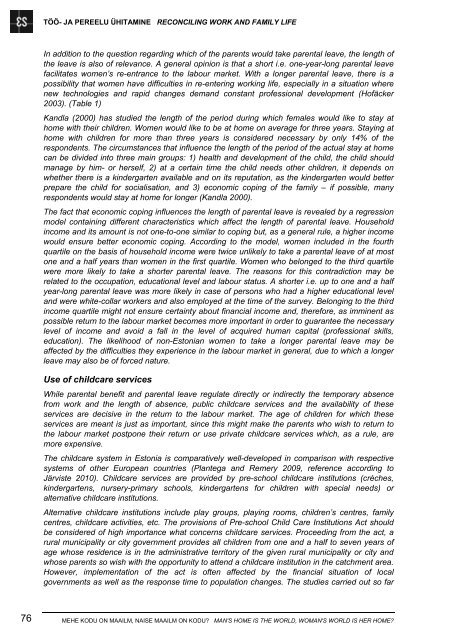MEHE KODU ON MAAILM, NAISE MAAILM ON KODU? - Tartu Ãlikool
MEHE KODU ON MAAILM, NAISE MAAILM ON KODU? - Tartu Ãlikool
MEHE KODU ON MAAILM, NAISE MAAILM ON KODU? - Tartu Ãlikool
Create successful ePaper yourself
Turn your PDF publications into a flip-book with our unique Google optimized e-Paper software.
TÖÖ- JA PEREELU ÜHITAMINE REC<strong>ON</strong>CILING WORK AND FAMILY LIFE<br />
In addition to the question regarding which of the parents would take parental leave, the length of<br />
the leave is also of relevance. A general opinion is that a short i.e. one-year-long parental leave<br />
facilitates women’s re-entrance to the labour market. With a longer parental leave, there is a<br />
possibility that women have difficulties in re-entering working life, especially in a situation where<br />
new technologies and rapid changes demand constant professional development (Hofäcker<br />
2003). (Table 1)<br />
Kandla (2000) has studied the length of the period during which females would like to stay at<br />
home with their children. Women would like to be at home on average for three years. Staying at<br />
home with children for more than three years is considered necessary by only 14% of the<br />
respondents. The circumstances that influence the length of the period of the actual stay at home<br />
can be divided into three main groups: 1) health and development of the child, the child should<br />
manage by him- or herself, 2) at a certain time the child needs other children, it depends on<br />
whether there is a kindergarten available and on its reputation, as the kindergarten would better<br />
prepare the child for socialisation, and 3) economic coping of the family – if possible, many<br />
respondents would stay at home for longer (Kandla 2000).<br />
The fact that economic coping influences the length of parental leave is revealed by a regression<br />
model containing different characteristics which affect the length of parental leave. Household<br />
income and its amount is not one-to-one similar to coping but, as a general rule, a higher income<br />
would ensure better economic coping. According to the model, women included in the fourth<br />
quartile on the basis of household income were twice unlikely to take a parental leave of at most<br />
one and a half years than women in the first quartile. Women who belonged to the third quartile<br />
were more likely to take a shorter parental leave. The reasons for this contradiction may be<br />
related to the occupation, educational level and labour status. A shorter i.e. up to one and a half<br />
year-long parental leave was more likely in case of persons who had a higher educational level<br />
and were white-collar workers and also employed at the time of the survey. Belonging to the third<br />
income quartile might not ensure certainty about financial income and, therefore, as imminent as<br />
possible return to the labour market becomes more important in order to guarantee the necessary<br />
level of income and avoid a fall in the level of acquired human capital (professional skills,<br />
education). The likelihood of non-Estonian women to take a longer parental leave may be<br />
affected by the difficulties they experience in the labour market in general, due to which a longer<br />
leave may also be of forced nature.<br />
Use of childcare services<br />
While parental benefit and parental leave regulate directly or indirectly the temporary absence<br />
from work and the length of absence, public childcare services and the availability of these<br />
services are decisive in the return to the labour market. The age of children for which these<br />
services are meant is just as important, since this might make the parents who wish to return to<br />
the labour market postpone their return or use private childcare services which, as a rule, are<br />
more expensive.<br />
The childcare system in Estonia is comparatively well-developed in comparison with respective<br />
systems of other European countries (Plantega and Remery 2009, reference according to<br />
Järviste 2010). Childcare services are provided by pre-school childcare institutions (crèches,<br />
kindergartens, nursery-primary schools, kindergartens for children with special needs) or<br />
alternative childcare institutions.<br />
Alternative childcare institutions include play groups, playing rooms, children’s centres, family<br />
centres, childcare activities, etc. The provisions of Pre-school Child Care Institutions Act should<br />
be considered of high importance what concerns childcare services. Proceeding from the act, a<br />
rural municipality or city government provides all children from one and a half to seven years of<br />
age whose residence is in the administrative territory of the given rural municipality or city and<br />
whose parents so wish with the opportunity to attend a childcare institution in the catchment area.<br />
However, implementation of the act is often affected by the financial situation of local<br />
governments as well as the response time to population changes. The studies carried out so far<br />
76<br />
<strong>MEHE</strong> <strong>KODU</strong> <strong>ON</strong> <strong>MAAILM</strong>, <strong>NAISE</strong> <strong>MAAILM</strong> <strong>ON</strong> <strong>KODU</strong>? MAN'S HOME IS THE WORLD, WOMAN'S WORLD IS HER HOME?

















